Accounting for Managers: Analyzing Financial Statements & Key Concepts
VerifiedAdded on 2023/06/15
|8
|2150
|214
Report
AI Summary
This report provides a comprehensive overview of accounting for managers, covering essential topics such as the purpose of the statement of comprehensive income, the definition and recognition of income and expenses, and the money measurement concept. It delves into the statement of financial position, explaining assets, liabilities, and equity, along with their measurement. The report further differentiates between accrual and cash basis accounting, elaborates on the matching concept, and outlines the four underlying principles of the accrual basis. A cost of sales adjustment example illustrates practical application. Desklib offers this student-contributed document and many other resources to aid students in their studies.
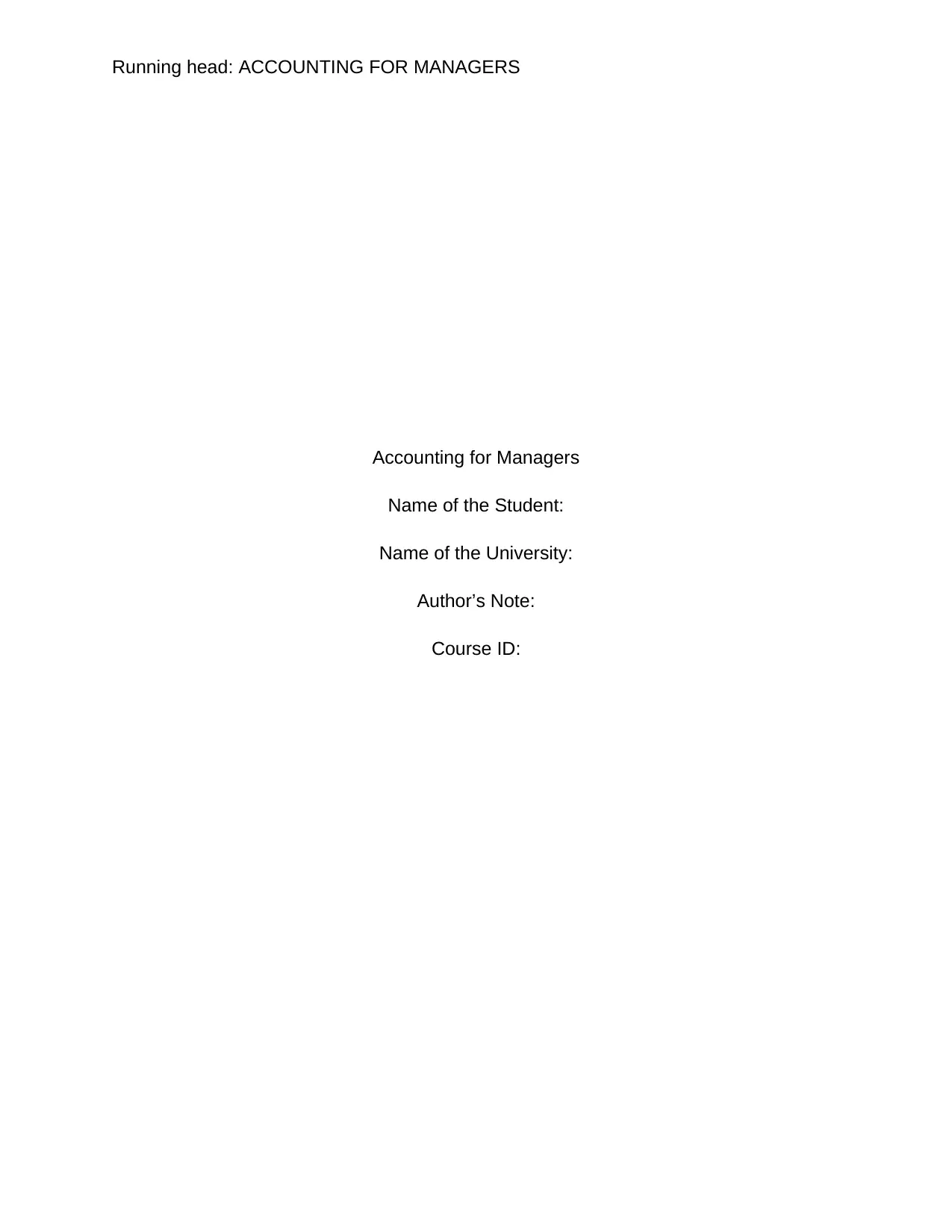
Running head: ACCOUNTING FOR MANAGERS
Accounting for Managers
Name of the Student:
Name of the University:
Author’s Note:
Course ID:
Accounting for Managers
Name of the Student:
Name of the University:
Author’s Note:
Course ID:
Paraphrase This Document
Need a fresh take? Get an instant paraphrase of this document with our AI Paraphraser
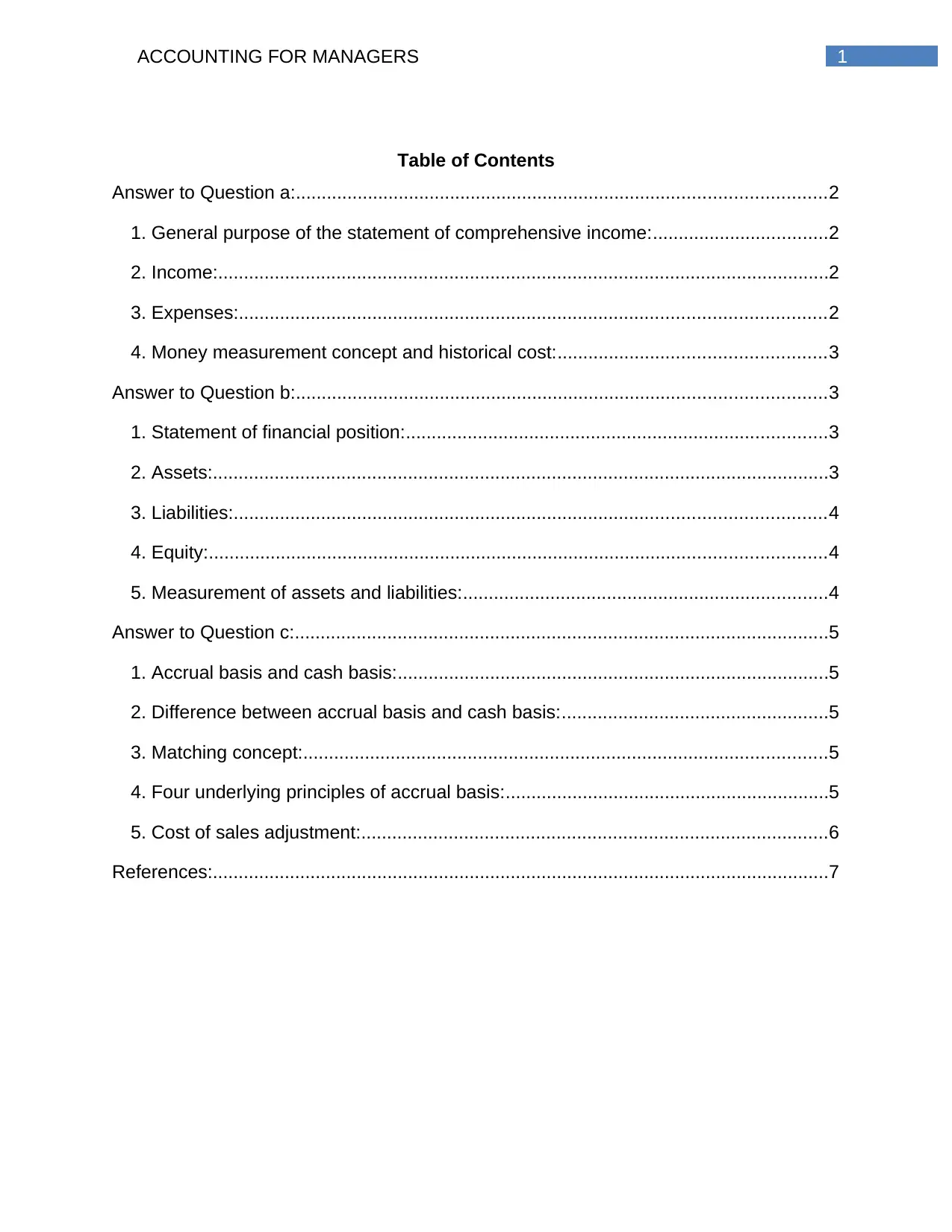
1ACCOUNTING FOR MANAGERS
Table of Contents
Answer to Question a:.......................................................................................................2
1. General purpose of the statement of comprehensive income:..................................2
2. Income:.......................................................................................................................2
3. Expenses:..................................................................................................................2
4. Money measurement concept and historical cost:....................................................3
Answer to Question b:.......................................................................................................3
1. Statement of financial position:..................................................................................3
2. Assets:........................................................................................................................3
3. Liabilities:...................................................................................................................4
4. Equity:........................................................................................................................4
5. Measurement of assets and liabilities:.......................................................................4
Answer to Question c:........................................................................................................5
1. Accrual basis and cash basis:....................................................................................5
2. Difference between accrual basis and cash basis:....................................................5
3. Matching concept:......................................................................................................5
4. Four underlying principles of accrual basis:...............................................................5
5. Cost of sales adjustment:...........................................................................................6
References:........................................................................................................................7
Table of Contents
Answer to Question a:.......................................................................................................2
1. General purpose of the statement of comprehensive income:..................................2
2. Income:.......................................................................................................................2
3. Expenses:..................................................................................................................2
4. Money measurement concept and historical cost:....................................................3
Answer to Question b:.......................................................................................................3
1. Statement of financial position:..................................................................................3
2. Assets:........................................................................................................................3
3. Liabilities:...................................................................................................................4
4. Equity:........................................................................................................................4
5. Measurement of assets and liabilities:.......................................................................4
Answer to Question c:........................................................................................................5
1. Accrual basis and cash basis:....................................................................................5
2. Difference between accrual basis and cash basis:....................................................5
3. Matching concept:......................................................................................................5
4. Four underlying principles of accrual basis:...............................................................5
5. Cost of sales adjustment:...........................................................................................6
References:........................................................................................................................7
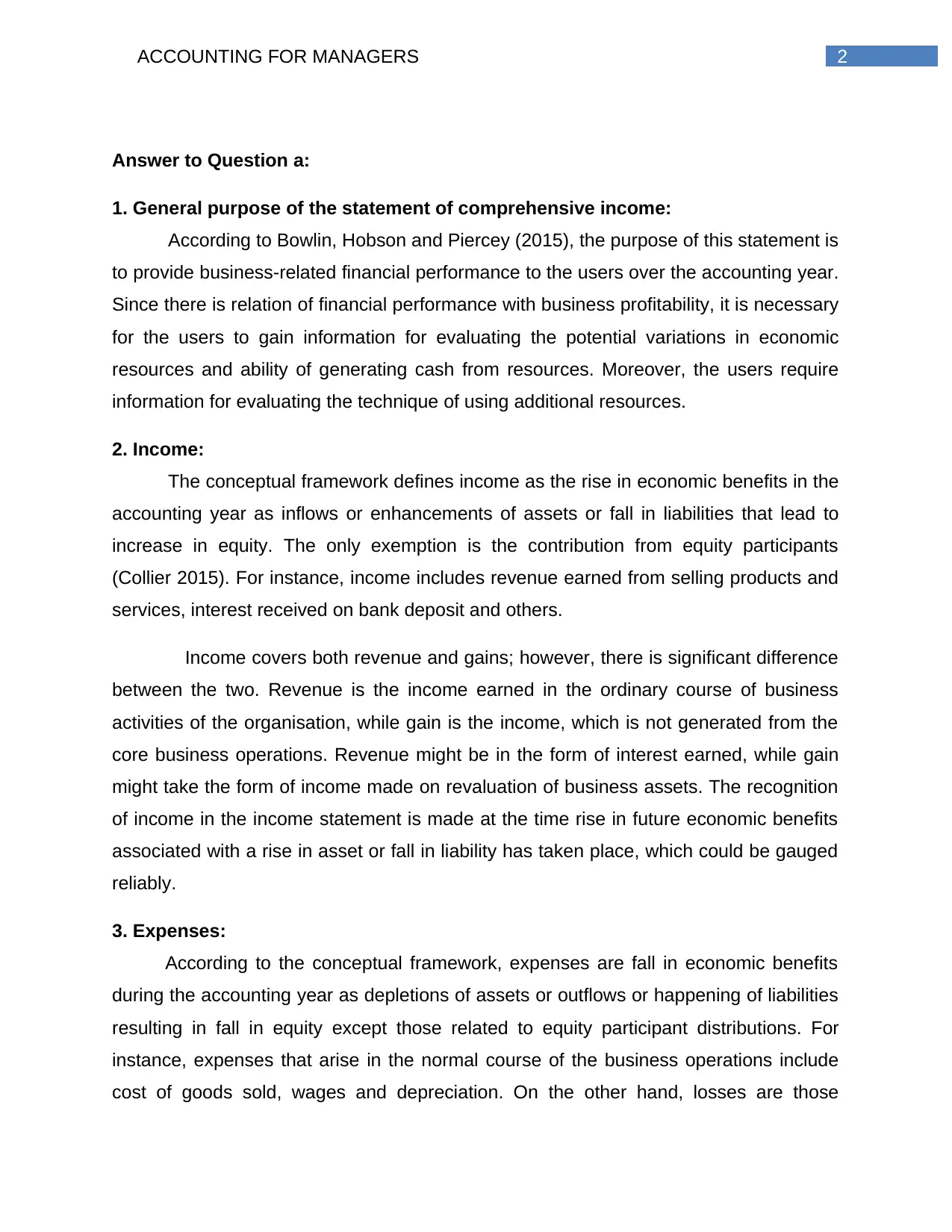
2ACCOUNTING FOR MANAGERS
Answer to Question a:
1. General purpose of the statement of comprehensive income:
According to Bowlin, Hobson and Piercey (2015), the purpose of this statement is
to provide business-related financial performance to the users over the accounting year.
Since there is relation of financial performance with business profitability, it is necessary
for the users to gain information for evaluating the potential variations in economic
resources and ability of generating cash from resources. Moreover, the users require
information for evaluating the technique of using additional resources.
2. Income:
The conceptual framework defines income as the rise in economic benefits in the
accounting year as inflows or enhancements of assets or fall in liabilities that lead to
increase in equity. The only exemption is the contribution from equity participants
(Collier 2015). For instance, income includes revenue earned from selling products and
services, interest received on bank deposit and others.
Income covers both revenue and gains; however, there is significant difference
between the two. Revenue is the income earned in the ordinary course of business
activities of the organisation, while gain is the income, which is not generated from the
core business operations. Revenue might be in the form of interest earned, while gain
might take the form of income made on revaluation of business assets. The recognition
of income in the income statement is made at the time rise in future economic benefits
associated with a rise in asset or fall in liability has taken place, which could be gauged
reliably.
3. Expenses:
According to the conceptual framework, expenses are fall in economic benefits
during the accounting year as depletions of assets or outflows or happening of liabilities
resulting in fall in equity except those related to equity participant distributions. For
instance, expenses that arise in the normal course of the business operations include
cost of goods sold, wages and depreciation. On the other hand, losses are those
Answer to Question a:
1. General purpose of the statement of comprehensive income:
According to Bowlin, Hobson and Piercey (2015), the purpose of this statement is
to provide business-related financial performance to the users over the accounting year.
Since there is relation of financial performance with business profitability, it is necessary
for the users to gain information for evaluating the potential variations in economic
resources and ability of generating cash from resources. Moreover, the users require
information for evaluating the technique of using additional resources.
2. Income:
The conceptual framework defines income as the rise in economic benefits in the
accounting year as inflows or enhancements of assets or fall in liabilities that lead to
increase in equity. The only exemption is the contribution from equity participants
(Collier 2015). For instance, income includes revenue earned from selling products and
services, interest received on bank deposit and others.
Income covers both revenue and gains; however, there is significant difference
between the two. Revenue is the income earned in the ordinary course of business
activities of the organisation, while gain is the income, which is not generated from the
core business operations. Revenue might be in the form of interest earned, while gain
might take the form of income made on revaluation of business assets. The recognition
of income in the income statement is made at the time rise in future economic benefits
associated with a rise in asset or fall in liability has taken place, which could be gauged
reliably.
3. Expenses:
According to the conceptual framework, expenses are fall in economic benefits
during the accounting year as depletions of assets or outflows or happening of liabilities
resulting in fall in equity except those related to equity participant distributions. For
instance, expenses that arise in the normal course of the business operations include
cost of goods sold, wages and depreciation. On the other hand, losses are those
⊘ This is a preview!⊘
Do you want full access?
Subscribe today to unlock all pages.

Trusted by 1+ million students worldwide
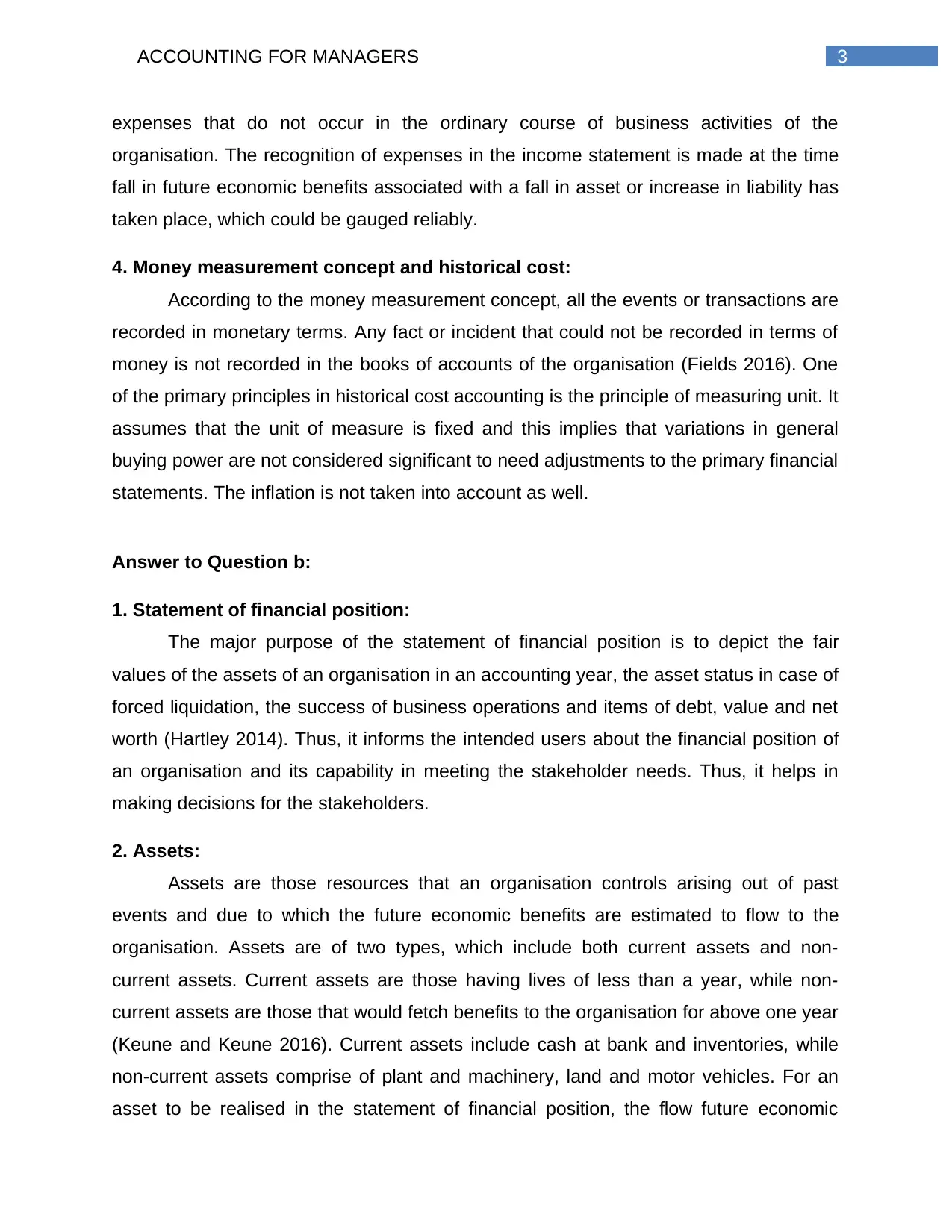
3ACCOUNTING FOR MANAGERS
expenses that do not occur in the ordinary course of business activities of the
organisation. The recognition of expenses in the income statement is made at the time
fall in future economic benefits associated with a fall in asset or increase in liability has
taken place, which could be gauged reliably.
4. Money measurement concept and historical cost:
According to the money measurement concept, all the events or transactions are
recorded in monetary terms. Any fact or incident that could not be recorded in terms of
money is not recorded in the books of accounts of the organisation (Fields 2016). One
of the primary principles in historical cost accounting is the principle of measuring unit. It
assumes that the unit of measure is fixed and this implies that variations in general
buying power are not considered significant to need adjustments to the primary financial
statements. The inflation is not taken into account as well.
Answer to Question b:
1. Statement of financial position:
The major purpose of the statement of financial position is to depict the fair
values of the assets of an organisation in an accounting year, the asset status in case of
forced liquidation, the success of business operations and items of debt, value and net
worth (Hartley 2014). Thus, it informs the intended users about the financial position of
an organisation and its capability in meeting the stakeholder needs. Thus, it helps in
making decisions for the stakeholders.
2. Assets:
Assets are those resources that an organisation controls arising out of past
events and due to which the future economic benefits are estimated to flow to the
organisation. Assets are of two types, which include both current assets and non-
current assets. Current assets are those having lives of less than a year, while non-
current assets are those that would fetch benefits to the organisation for above one year
(Keune and Keune 2016). Current assets include cash at bank and inventories, while
non-current assets comprise of plant and machinery, land and motor vehicles. For an
asset to be realised in the statement of financial position, the flow future economic
expenses that do not occur in the ordinary course of business activities of the
organisation. The recognition of expenses in the income statement is made at the time
fall in future economic benefits associated with a fall in asset or increase in liability has
taken place, which could be gauged reliably.
4. Money measurement concept and historical cost:
According to the money measurement concept, all the events or transactions are
recorded in monetary terms. Any fact or incident that could not be recorded in terms of
money is not recorded in the books of accounts of the organisation (Fields 2016). One
of the primary principles in historical cost accounting is the principle of measuring unit. It
assumes that the unit of measure is fixed and this implies that variations in general
buying power are not considered significant to need adjustments to the primary financial
statements. The inflation is not taken into account as well.
Answer to Question b:
1. Statement of financial position:
The major purpose of the statement of financial position is to depict the fair
values of the assets of an organisation in an accounting year, the asset status in case of
forced liquidation, the success of business operations and items of debt, value and net
worth (Hartley 2014). Thus, it informs the intended users about the financial position of
an organisation and its capability in meeting the stakeholder needs. Thus, it helps in
making decisions for the stakeholders.
2. Assets:
Assets are those resources that an organisation controls arising out of past
events and due to which the future economic benefits are estimated to flow to the
organisation. Assets are of two types, which include both current assets and non-
current assets. Current assets are those having lives of less than a year, while non-
current assets are those that would fetch benefits to the organisation for above one year
(Keune and Keune 2016). Current assets include cash at bank and inventories, while
non-current assets comprise of plant and machinery, land and motor vehicles. For an
asset to be realised in the statement of financial position, the flow future economic
Paraphrase This Document
Need a fresh take? Get an instant paraphrase of this document with our AI Paraphraser
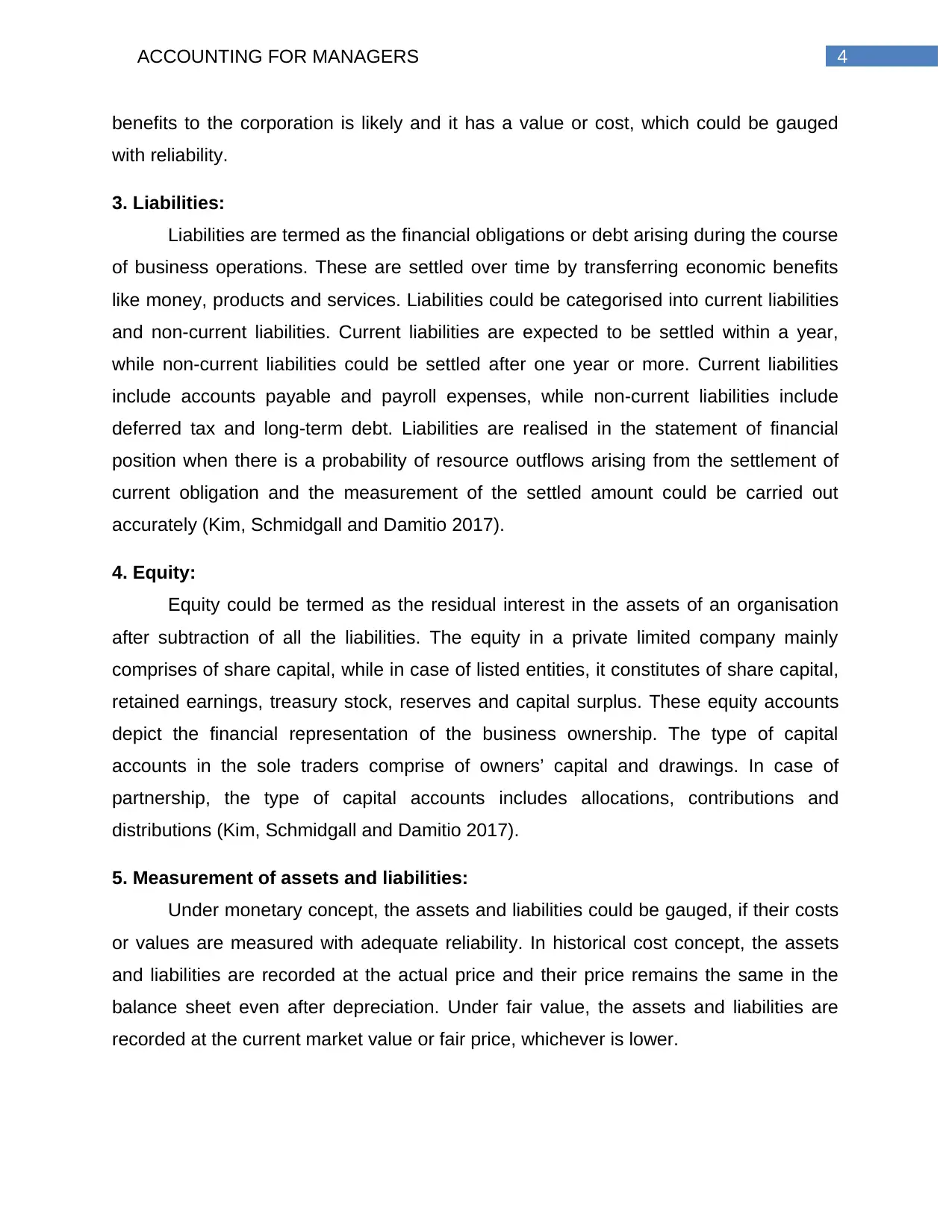
4ACCOUNTING FOR MANAGERS
benefits to the corporation is likely and it has a value or cost, which could be gauged
with reliability.
3. Liabilities:
Liabilities are termed as the financial obligations or debt arising during the course
of business operations. These are settled over time by transferring economic benefits
like money, products and services. Liabilities could be categorised into current liabilities
and non-current liabilities. Current liabilities are expected to be settled within a year,
while non-current liabilities could be settled after one year or more. Current liabilities
include accounts payable and payroll expenses, while non-current liabilities include
deferred tax and long-term debt. Liabilities are realised in the statement of financial
position when there is a probability of resource outflows arising from the settlement of
current obligation and the measurement of the settled amount could be carried out
accurately (Kim, Schmidgall and Damitio 2017).
4. Equity:
Equity could be termed as the residual interest in the assets of an organisation
after subtraction of all the liabilities. The equity in a private limited company mainly
comprises of share capital, while in case of listed entities, it constitutes of share capital,
retained earnings, treasury stock, reserves and capital surplus. These equity accounts
depict the financial representation of the business ownership. The type of capital
accounts in the sole traders comprise of owners’ capital and drawings. In case of
partnership, the type of capital accounts includes allocations, contributions and
distributions (Kim, Schmidgall and Damitio 2017).
5. Measurement of assets and liabilities:
Under monetary concept, the assets and liabilities could be gauged, if their costs
or values are measured with adequate reliability. In historical cost concept, the assets
and liabilities are recorded at the actual price and their price remains the same in the
balance sheet even after depreciation. Under fair value, the assets and liabilities are
recorded at the current market value or fair price, whichever is lower.
benefits to the corporation is likely and it has a value or cost, which could be gauged
with reliability.
3. Liabilities:
Liabilities are termed as the financial obligations or debt arising during the course
of business operations. These are settled over time by transferring economic benefits
like money, products and services. Liabilities could be categorised into current liabilities
and non-current liabilities. Current liabilities are expected to be settled within a year,
while non-current liabilities could be settled after one year or more. Current liabilities
include accounts payable and payroll expenses, while non-current liabilities include
deferred tax and long-term debt. Liabilities are realised in the statement of financial
position when there is a probability of resource outflows arising from the settlement of
current obligation and the measurement of the settled amount could be carried out
accurately (Kim, Schmidgall and Damitio 2017).
4. Equity:
Equity could be termed as the residual interest in the assets of an organisation
after subtraction of all the liabilities. The equity in a private limited company mainly
comprises of share capital, while in case of listed entities, it constitutes of share capital,
retained earnings, treasury stock, reserves and capital surplus. These equity accounts
depict the financial representation of the business ownership. The type of capital
accounts in the sole traders comprise of owners’ capital and drawings. In case of
partnership, the type of capital accounts includes allocations, contributions and
distributions (Kim, Schmidgall and Damitio 2017).
5. Measurement of assets and liabilities:
Under monetary concept, the assets and liabilities could be gauged, if their costs
or values are measured with adequate reliability. In historical cost concept, the assets
and liabilities are recorded at the actual price and their price remains the same in the
balance sheet even after depreciation. Under fair value, the assets and liabilities are
recorded at the current market value or fair price, whichever is lower.
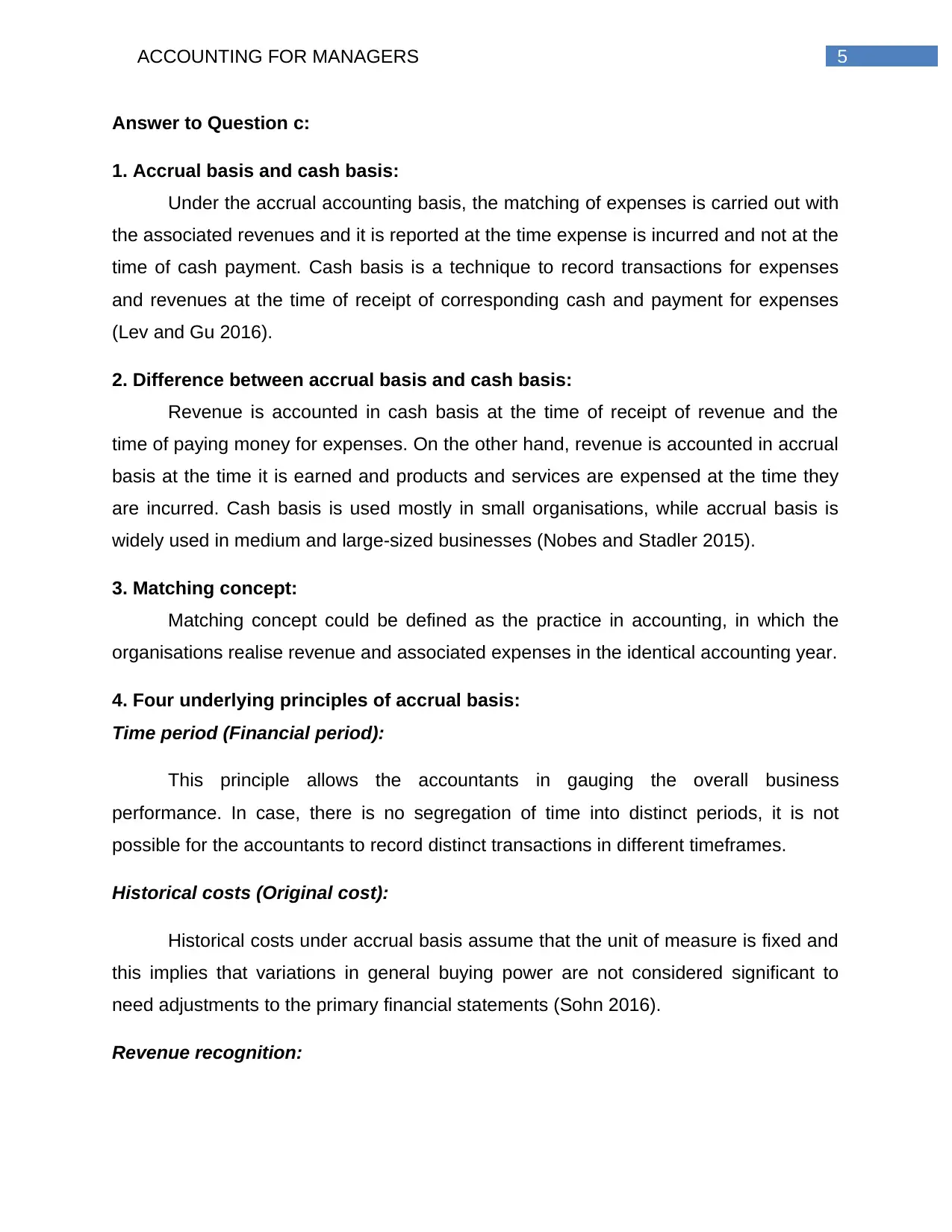
5ACCOUNTING FOR MANAGERS
Answer to Question c:
1. Accrual basis and cash basis:
Under the accrual accounting basis, the matching of expenses is carried out with
the associated revenues and it is reported at the time expense is incurred and not at the
time of cash payment. Cash basis is a technique to record transactions for expenses
and revenues at the time of receipt of corresponding cash and payment for expenses
(Lev and Gu 2016).
2. Difference between accrual basis and cash basis:
Revenue is accounted in cash basis at the time of receipt of revenue and the
time of paying money for expenses. On the other hand, revenue is accounted in accrual
basis at the time it is earned and products and services are expensed at the time they
are incurred. Cash basis is used mostly in small organisations, while accrual basis is
widely used in medium and large-sized businesses (Nobes and Stadler 2015).
3. Matching concept:
Matching concept could be defined as the practice in accounting, in which the
organisations realise revenue and associated expenses in the identical accounting year.
4. Four underlying principles of accrual basis:
Time period (Financial period):
This principle allows the accountants in gauging the overall business
performance. In case, there is no segregation of time into distinct periods, it is not
possible for the accountants to record distinct transactions in different timeframes.
Historical costs (Original cost):
Historical costs under accrual basis assume that the unit of measure is fixed and
this implies that variations in general buying power are not considered significant to
need adjustments to the primary financial statements (Sohn 2016).
Revenue recognition:
Answer to Question c:
1. Accrual basis and cash basis:
Under the accrual accounting basis, the matching of expenses is carried out with
the associated revenues and it is reported at the time expense is incurred and not at the
time of cash payment. Cash basis is a technique to record transactions for expenses
and revenues at the time of receipt of corresponding cash and payment for expenses
(Lev and Gu 2016).
2. Difference between accrual basis and cash basis:
Revenue is accounted in cash basis at the time of receipt of revenue and the
time of paying money for expenses. On the other hand, revenue is accounted in accrual
basis at the time it is earned and products and services are expensed at the time they
are incurred. Cash basis is used mostly in small organisations, while accrual basis is
widely used in medium and large-sized businesses (Nobes and Stadler 2015).
3. Matching concept:
Matching concept could be defined as the practice in accounting, in which the
organisations realise revenue and associated expenses in the identical accounting year.
4. Four underlying principles of accrual basis:
Time period (Financial period):
This principle allows the accountants in gauging the overall business
performance. In case, there is no segregation of time into distinct periods, it is not
possible for the accountants to record distinct transactions in different timeframes.
Historical costs (Original cost):
Historical costs under accrual basis assume that the unit of measure is fixed and
this implies that variations in general buying power are not considered significant to
need adjustments to the primary financial statements (Sohn 2016).
Revenue recognition:
⊘ This is a preview!⊘
Do you want full access?
Subscribe today to unlock all pages.

Trusted by 1+ million students worldwide
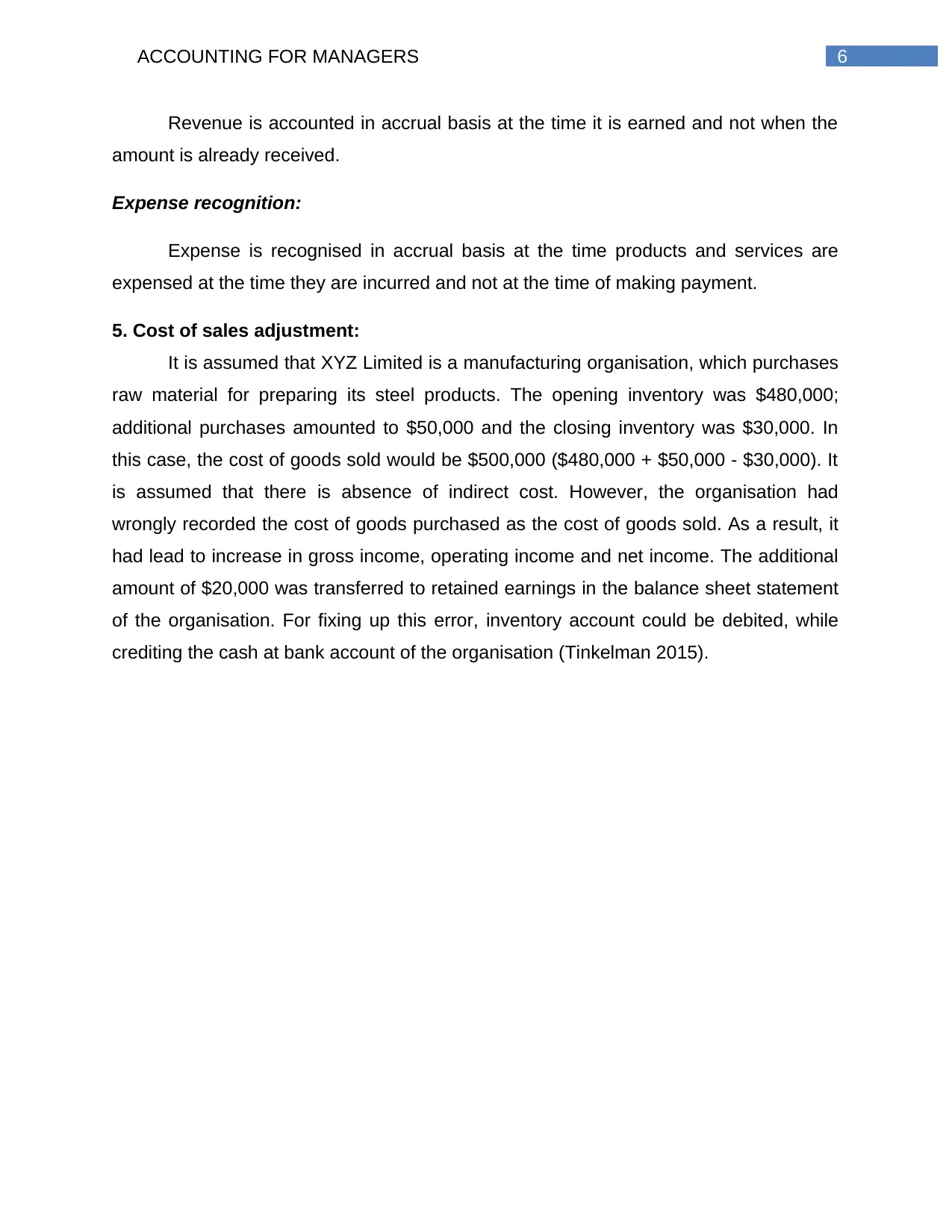
6ACCOUNTING FOR MANAGERS
Revenue is accounted in accrual basis at the time it is earned and not when the
amount is already received.
Expense recognition:
Expense is recognised in accrual basis at the time products and services are
expensed at the time they are incurred and not at the time of making payment.
5. Cost of sales adjustment:
It is assumed that XYZ Limited is a manufacturing organisation, which purchases
raw material for preparing its steel products. The opening inventory was $480,000;
additional purchases amounted to $50,000 and the closing inventory was $30,000. In
this case, the cost of goods sold would be $500,000 ($480,000 + $50,000 - $30,000). It
is assumed that there is absence of indirect cost. However, the organisation had
wrongly recorded the cost of goods purchased as the cost of goods sold. As a result, it
had lead to increase in gross income, operating income and net income. The additional
amount of $20,000 was transferred to retained earnings in the balance sheet statement
of the organisation. For fixing up this error, inventory account could be debited, while
crediting the cash at bank account of the organisation (Tinkelman 2015).
Revenue is accounted in accrual basis at the time it is earned and not when the
amount is already received.
Expense recognition:
Expense is recognised in accrual basis at the time products and services are
expensed at the time they are incurred and not at the time of making payment.
5. Cost of sales adjustment:
It is assumed that XYZ Limited is a manufacturing organisation, which purchases
raw material for preparing its steel products. The opening inventory was $480,000;
additional purchases amounted to $50,000 and the closing inventory was $30,000. In
this case, the cost of goods sold would be $500,000 ($480,000 + $50,000 - $30,000). It
is assumed that there is absence of indirect cost. However, the organisation had
wrongly recorded the cost of goods purchased as the cost of goods sold. As a result, it
had lead to increase in gross income, operating income and net income. The additional
amount of $20,000 was transferred to retained earnings in the balance sheet statement
of the organisation. For fixing up this error, inventory account could be debited, while
crediting the cash at bank account of the organisation (Tinkelman 2015).
Paraphrase This Document
Need a fresh take? Get an instant paraphrase of this document with our AI Paraphraser
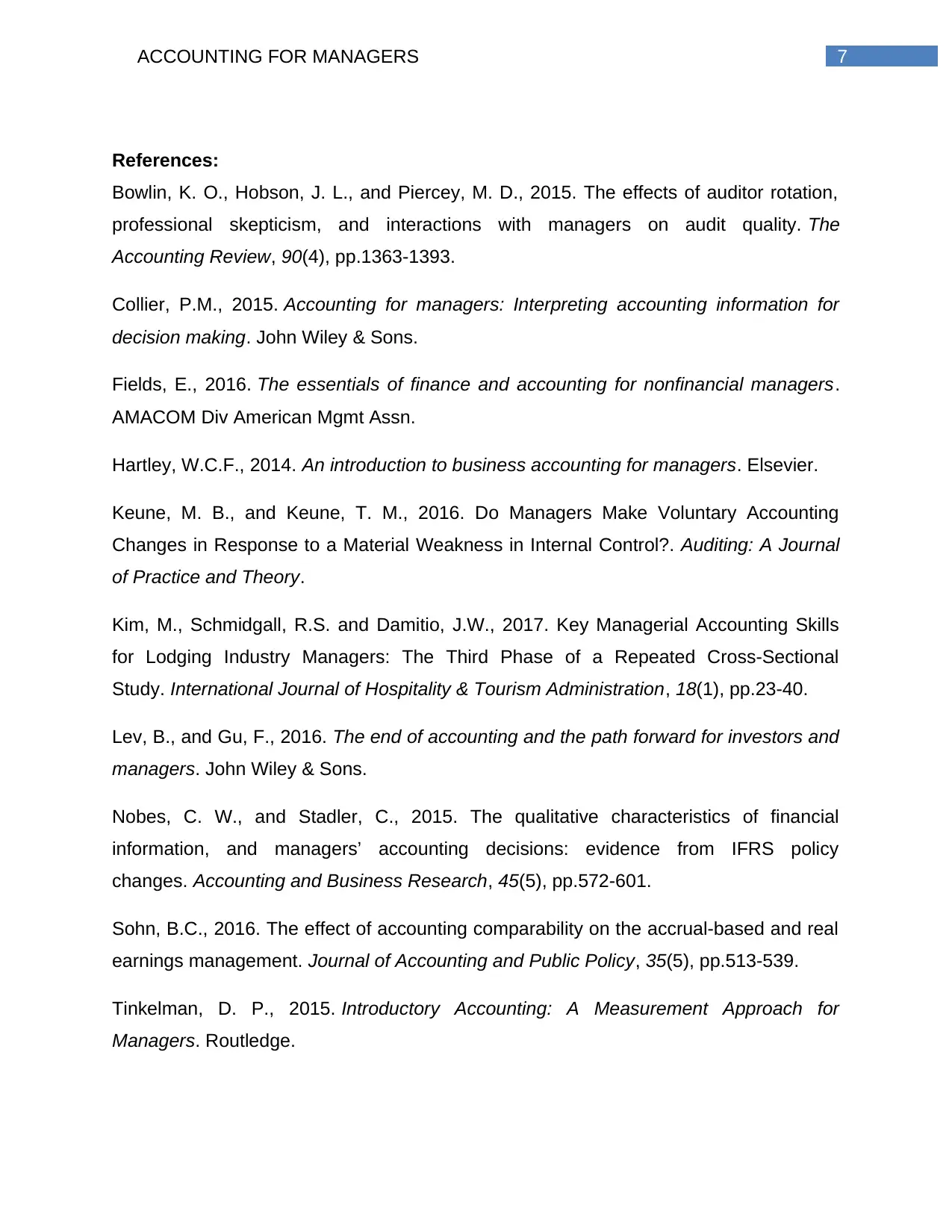
7ACCOUNTING FOR MANAGERS
References:
Bowlin, K. O., Hobson, J. L., and Piercey, M. D., 2015. The effects of auditor rotation,
professional skepticism, and interactions with managers on audit quality. The
Accounting Review, 90(4), pp.1363-1393.
Collier, P.M., 2015. Accounting for managers: Interpreting accounting information for
decision making. John Wiley & Sons.
Fields, E., 2016. The essentials of finance and accounting for nonfinancial managers.
AMACOM Div American Mgmt Assn.
Hartley, W.C.F., 2014. An introduction to business accounting for managers. Elsevier.
Keune, M. B., and Keune, T. M., 2016. Do Managers Make Voluntary Accounting
Changes in Response to a Material Weakness in Internal Control?. Auditing: A Journal
of Practice and Theory.
Kim, M., Schmidgall, R.S. and Damitio, J.W., 2017. Key Managerial Accounting Skills
for Lodging Industry Managers: The Third Phase of a Repeated Cross-Sectional
Study. International Journal of Hospitality & Tourism Administration, 18(1), pp.23-40.
Lev, B., and Gu, F., 2016. The end of accounting and the path forward for investors and
managers. John Wiley & Sons.
Nobes, C. W., and Stadler, C., 2015. The qualitative characteristics of financial
information, and managers’ accounting decisions: evidence from IFRS policy
changes. Accounting and Business Research, 45(5), pp.572-601.
Sohn, B.C., 2016. The effect of accounting comparability on the accrual-based and real
earnings management. Journal of Accounting and Public Policy, 35(5), pp.513-539.
Tinkelman, D. P., 2015. Introductory Accounting: A Measurement Approach for
Managers. Routledge.
References:
Bowlin, K. O., Hobson, J. L., and Piercey, M. D., 2015. The effects of auditor rotation,
professional skepticism, and interactions with managers on audit quality. The
Accounting Review, 90(4), pp.1363-1393.
Collier, P.M., 2015. Accounting for managers: Interpreting accounting information for
decision making. John Wiley & Sons.
Fields, E., 2016. The essentials of finance and accounting for nonfinancial managers.
AMACOM Div American Mgmt Assn.
Hartley, W.C.F., 2014. An introduction to business accounting for managers. Elsevier.
Keune, M. B., and Keune, T. M., 2016. Do Managers Make Voluntary Accounting
Changes in Response to a Material Weakness in Internal Control?. Auditing: A Journal
of Practice and Theory.
Kim, M., Schmidgall, R.S. and Damitio, J.W., 2017. Key Managerial Accounting Skills
for Lodging Industry Managers: The Third Phase of a Repeated Cross-Sectional
Study. International Journal of Hospitality & Tourism Administration, 18(1), pp.23-40.
Lev, B., and Gu, F., 2016. The end of accounting and the path forward for investors and
managers. John Wiley & Sons.
Nobes, C. W., and Stadler, C., 2015. The qualitative characteristics of financial
information, and managers’ accounting decisions: evidence from IFRS policy
changes. Accounting and Business Research, 45(5), pp.572-601.
Sohn, B.C., 2016. The effect of accounting comparability on the accrual-based and real
earnings management. Journal of Accounting and Public Policy, 35(5), pp.513-539.
Tinkelman, D. P., 2015. Introductory Accounting: A Measurement Approach for
Managers. Routledge.
1 out of 8
Related Documents
Your All-in-One AI-Powered Toolkit for Academic Success.
+13062052269
info@desklib.com
Available 24*7 on WhatsApp / Email
![[object Object]](/_next/static/media/star-bottom.7253800d.svg)
Unlock your academic potential
Copyright © 2020–2025 A2Z Services. All Rights Reserved. Developed and managed by ZUCOL.




